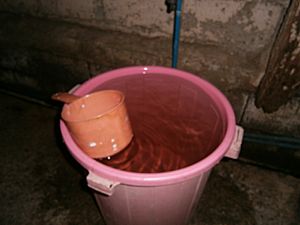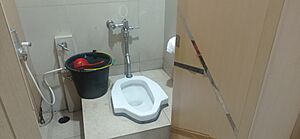Tabo (hygiene) facts for kids
The tabò is a special dipper used for cleaning and bathing in the Philippines and other Southeast Asian countries. You can find it in places like Indonesia, East Timor, Malaysia, Vietnam, and Brunei. In the Philippines, it's called tabò. In Indonesia and Malaysia, it's known as gayung or cebok.
Many Filipinos, even those living in other countries, find the tabò very important. It's more than just a simple dipper. It's a key part of daily life in many homes.
Besides bathing, the tabò is also used for other things around the house. For example, it can help measure liquids. A common tabò often holds about one liter of water. This is because many are made from old one-liter motor oil containers.
The tabò looks a bit like the hishaku from Japan. The hishaku is a water dipper with a bamboo handle.
Contents
How the Tabò Was Made
The tabò is the Filipino version of a dipper used across Southeast Asia. Long ago, tabòs were made from natural materials. These included coconut shells and bamboo. They were not used in toilets back then.
From Nature to Plastic
The "modern" tabò came about when plastic was invented. This new material made it easier to create the dipper. Before plastic, people used coconut and bamboo. In the past, the tabò was sometimes called a sartin. This name came from the Spanish word sartén.
Historians say that early Filipinos developed this tool to save time and water. Water sources were not always close by. So, instead of walking to wash their hands, people passed the sartin around.
Early Uses Around the Home
In old traditional homes, the tabò was not just for the bathroom. It was an all-purpose item. You might find it at the entrance of a house. It would be next to a clay water jar called a palayók. Guests could wash their hands and feet before coming inside. This showed good manners from both the host and the guest.
The tabò was also in the kitchen with the palayók. The palayók kept drinking water cool. The tabò was there to get water for drinking or for washing hands and dishes. This shows how much people cared about cleanliness back then. Over time, the palayók and tabò became less common. The tabò mostly ended up in the bathroom for personal cleaning.
How the Tabò Is Used Today
Today, the plastic tabò is mainly kept in the bathroom. It's used as a water dipper for many tasks. It's important to use it carefully to avoid making a mess.
Its main job is to help with cleaning. People use it to clean the bathroom floor. They also use it to get water to flush the toilet. Most importantly, it's used for personal cleanliness.
Many Filipinos use the tabò to wash themselves after using the toilet. They might use it instead of, or in addition to, toilet paper. Not all toilets in the Philippines have an automatic flush. In these cases, a timbâ (a plastic pail) and a tabò are used. The tabò floats inside the pail. Before using the toilet, people check if the pail has enough water.
After using the toilet, Filipinos wash their hands very well. They use water and soap or other cleaning products.
The Tabò in Filipino Culture
Language and Washing
A long time ago, in the 1600s, a Jesuit priest named Ignacio Alcina noticed something interesting. In the Visayan languages of the Philippines, there were different words for washing feet, hands, or other body parts. This shows how important washing was, and many of these actions likely involved the tabò.
Eco-Friendly and Water Saving
The traditional tabò was made from coconut shells and bamboo. These are common items in the Philippines. Using them was a way to recycle natural materials.
The tabò also helps save water. Water can be scarce in many Filipino homes. The tabò allows people to use just enough water for cleaning. The modern plastic tabò is especially good at this. It holds enough water to help flush a toilet effectively, but it still requires some skill to use it just right.
See also
- Istinja – A similar cleaning practice in Muslim cultures.
- Lota (vessel) – A similar vessel used in India and Africa.
- Ladle (spoon)



